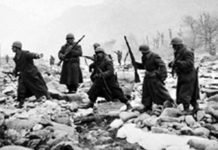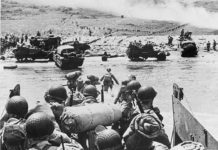During the Cheyenne Indian Wars, the Battle of Beecher Island was waged between a desperate party of scouts and a large, angry enemy in frontier Colorado.
The Battle of Beecher Island, fought from September 16-21 1868, pitted a small army scouting detachment against a much larger Indian force echoing similarities to the Wagon Box and Hayfield fights waged in Montana and Wyoming the previous summer. Utilizing a fortified defensive position, the scouts were able to withstand what appeared to be a massacre in the making. Though not considered among the major battles of the Indian Wars, it holds valuable significance as an example of the army’s overestimation of its tactical ability as well as a remarkable test of human will and endurance.
Forsyth and the Cheyenne Indians: Angering a Giant
In August 1868, Major George Forsyth was ordered to raise a group of 50 scouts to locate and engage Cheyenne warriors that were harassing local homesteaders and workers constructing the Kansas Pacific Railroad. Recruiting 20 men from Ft Harker and another 30 from Ft Hays, Forsyth was called to Sheridan, Kansas to track a war party that had attacked a train of freight wagons, killing two teamsters.
After several days struggling to track the fleeing warriors, Forsyth’s column overtook the trail of a very large group of Indians that had recently passed through the area. He decided that his force was large enough to engage a sizeable enemy band and they continued followed it to the Arikaree fork of the Republican River.
Choosing in a broad valley on the river, the column halted and made camp near a sandy island roughly 250 feet long and 70 feet wide. Forsythe and his lead scouts correctly guessed that they were very close to overtaking their quarry. As a precaution, extra sentries were posted for the night and the men were ordered to secure their horses in the event of a stampede attempt. What they did not know was that the large enemy camp was aware of their presence.
Beecher Island and the Cheyenne Warrior, Roman Nose
At daybreak, a dozen warriors were spotted charging in on the horse herd. After running off four animals, they retreated. Within minutes, 1000 Cheyenne, Sioux and Arapaho warriors came into view on every side of the camp. Seeing no opportunity for escape, Forsyth ordered his men to lead their horses to the island to set up a defensive perimeter along its circumference. Warriors along both river banks began firing at them.
The scouts briefly returned fire. Desperate to escape the barrage of bullets, they used knives and coffee cups to dig shallow trenches to lie in. In the melee, Forsythe was hit in the right thigh. Soon after, his left shin bone was shattered by another gunshot. Lieutenant Fredrick Beecher, his second in command, was mortally wounded along with several others. Continuing to lead his men, Forsyth was glanced in the scalp by another bullet, temporarily leaving him stunned. Virtually every horse in the command lay dead or dying on the edges of the island.
A prominent Cheyenne warrior, Roman Nose, led a series of charges on the stronghold along with several hundred warriors. The scouts were able to prevent the island from being overrun by using their Spencer rifles and Colt Army pistols to break the charges and scatter the survivors. At some point Roman Nose and his horse were cut down by their gunfire.
Beecher Island Laid to Siege
The somewhat disheartened warriors attempted two more unsuccessful charges before retiring to the surrounding bluffs. Their tactics changed to firing long-range at the entrenched detachment. Indian women and children that had lined the hills to witness the battle began to withdraw. Their men, however, would continue to pin down the besieged scouts for several days.








